Express & Implied Contract Terms
VerifiedAdded on 2020/05/28
|11
|2444
|148
AI Summary
This assignment delves into the distinction between express and implied contract terms. It examines how these terms are defined, how they arise within a contract, and the challenges associated with proving their existence. The analysis highlights the interplay between express and implied terms, emphasizing that while distinct, they often work in tandem to ensure the proper functioning of contractual agreements.
Contribute Materials
Your contribution can guide someone’s learning journey. Share your
documents today.
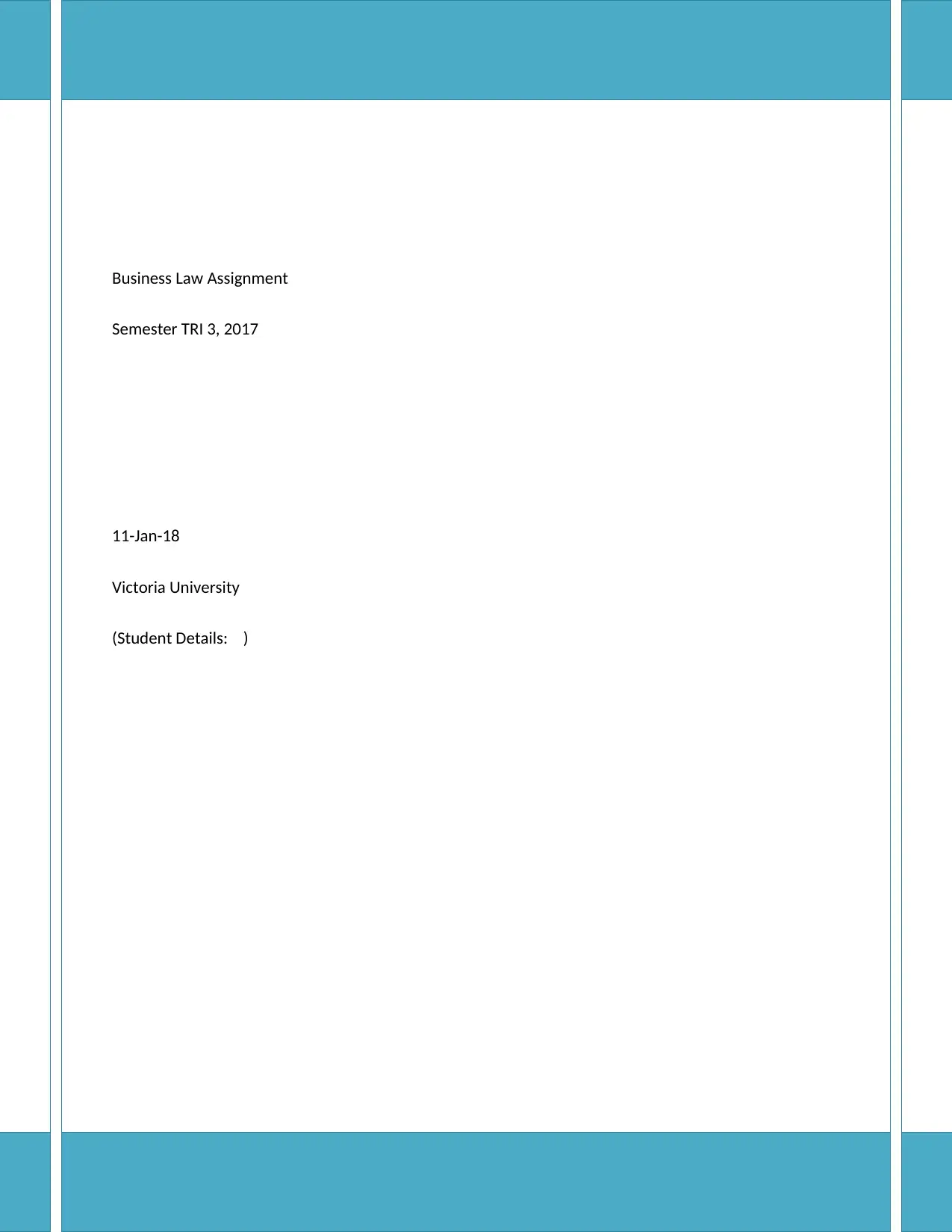
Business Law Assignment
Semester TRI 3, 2017
11-Jan-18
Victoria University
(Student Details: )
Semester TRI 3, 2017
11-Jan-18
Victoria University
(Student Details: )
Secure Best Marks with AI Grader
Need help grading? Try our AI Grader for instant feedback on your assignments.
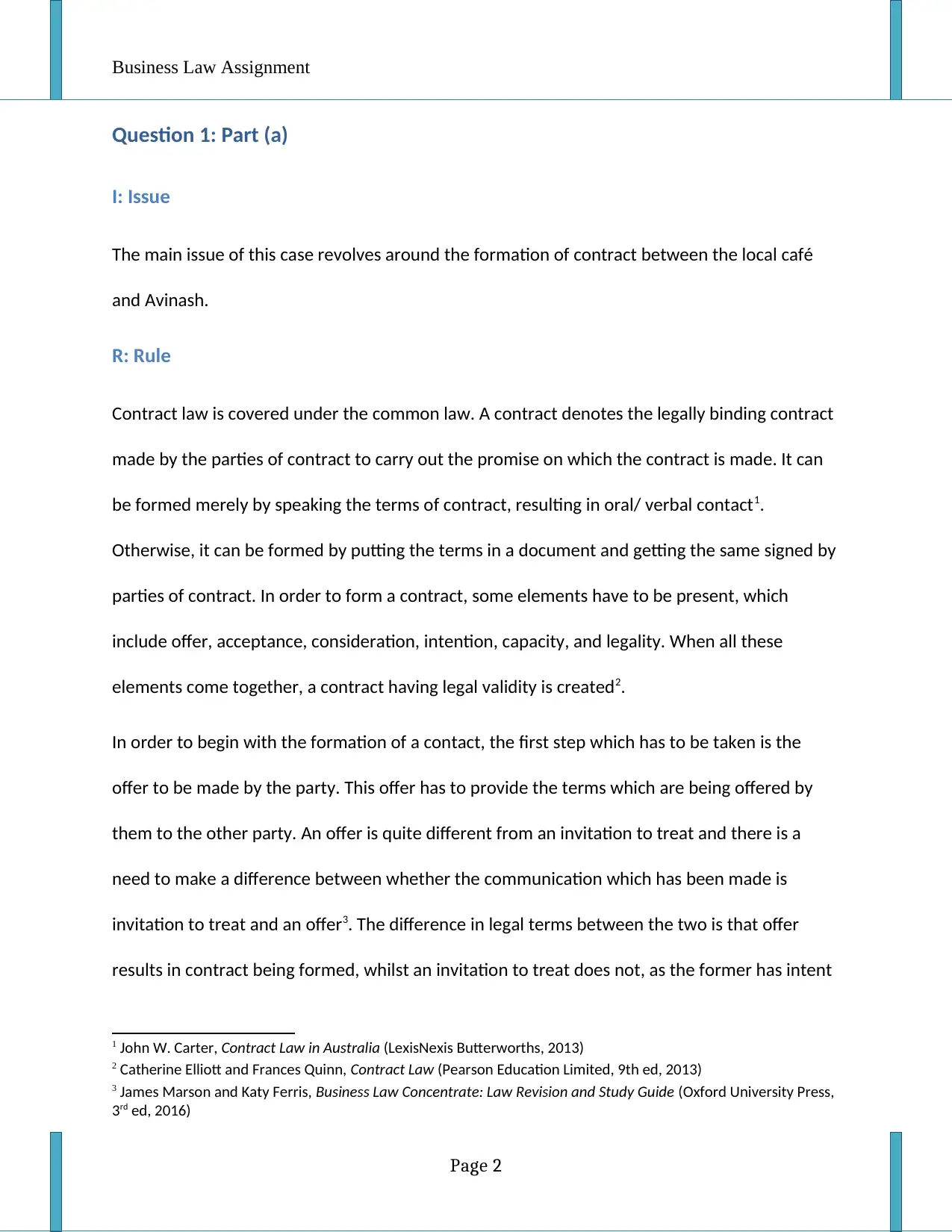
Business Law Assignment
Question 1: Part (a)
I: Issue
The main issue of this case revolves around the formation of contract between the local café
and Avinash.
R: Rule
Contract law is covered under the common law. A contract denotes the legally binding contract
made by the parties of contract to carry out the promise on which the contract is made. It can
be formed merely by speaking the terms of contract, resulting in oral/ verbal contact1.
Otherwise, it can be formed by putting the terms in a document and getting the same signed by
parties of contract. In order to form a contract, some elements have to be present, which
include offer, acceptance, consideration, intention, capacity, and legality. When all these
elements come together, a contract having legal validity is created2.
In order to begin with the formation of a contact, the first step which has to be taken is the
offer to be made by the party. This offer has to provide the terms which are being offered by
them to the other party. An offer is quite different from an invitation to treat and there is a
need to make a difference between whether the communication which has been made is
invitation to treat and an offer3. The difference in legal terms between the two is that offer
results in contract being formed, whilst an invitation to treat does not, as the former has intent
1 John W. Carter, Contract Law in Australia (LexisNexis Butterworths, 2013)
2 Catherine Elliott and Frances Quinn, Contract Law (Pearson Education Limited, 9th ed, 2013)
3 James Marson and Katy Ferris, Business Law Concentrate: Law Revision and Study Guide (Oxford University Press,
3rd ed, 2016)
Page 2
Question 1: Part (a)
I: Issue
The main issue of this case revolves around the formation of contract between the local café
and Avinash.
R: Rule
Contract law is covered under the common law. A contract denotes the legally binding contract
made by the parties of contract to carry out the promise on which the contract is made. It can
be formed merely by speaking the terms of contract, resulting in oral/ verbal contact1.
Otherwise, it can be formed by putting the terms in a document and getting the same signed by
parties of contract. In order to form a contract, some elements have to be present, which
include offer, acceptance, consideration, intention, capacity, and legality. When all these
elements come together, a contract having legal validity is created2.
In order to begin with the formation of a contact, the first step which has to be taken is the
offer to be made by the party. This offer has to provide the terms which are being offered by
them to the other party. An offer is quite different from an invitation to treat and there is a
need to make a difference between whether the communication which has been made is
invitation to treat and an offer3. The difference in legal terms between the two is that offer
results in contract being formed, whilst an invitation to treat does not, as the former has intent
1 John W. Carter, Contract Law in Australia (LexisNexis Butterworths, 2013)
2 Catherine Elliott and Frances Quinn, Contract Law (Pearson Education Limited, 9th ed, 2013)
3 James Marson and Katy Ferris, Business Law Concentrate: Law Revision and Study Guide (Oxford University Press,
3rd ed, 2016)
Page 2
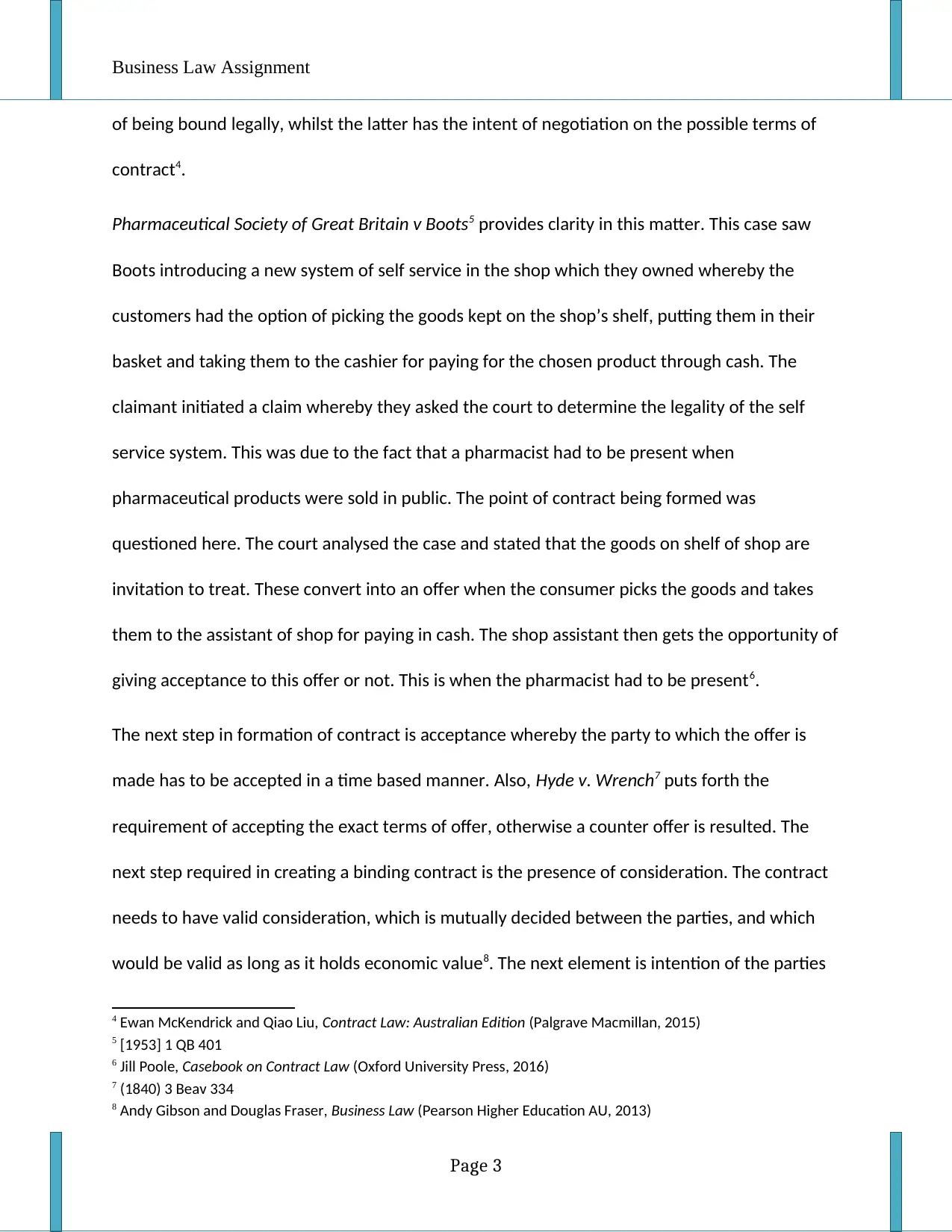
Business Law Assignment
of being bound legally, whilst the latter has the intent of negotiation on the possible terms of
contract4.
Pharmaceutical Society of Great Britain v Boots5 provides clarity in this matter. This case saw
Boots introducing a new system of self service in the shop which they owned whereby the
customers had the option of picking the goods kept on the shop’s shelf, putting them in their
basket and taking them to the cashier for paying for the chosen product through cash. The
claimant initiated a claim whereby they asked the court to determine the legality of the self
service system. This was due to the fact that a pharmacist had to be present when
pharmaceutical products were sold in public. The point of contract being formed was
questioned here. The court analysed the case and stated that the goods on shelf of shop are
invitation to treat. These convert into an offer when the consumer picks the goods and takes
them to the assistant of shop for paying in cash. The shop assistant then gets the opportunity of
giving acceptance to this offer or not. This is when the pharmacist had to be present6.
The next step in formation of contract is acceptance whereby the party to which the offer is
made has to be accepted in a time based manner. Also, Hyde v. Wrench7 puts forth the
requirement of accepting the exact terms of offer, otherwise a counter offer is resulted. The
next step required in creating a binding contract is the presence of consideration. The contract
needs to have valid consideration, which is mutually decided between the parties, and which
would be valid as long as it holds economic value8. The next element is intention of the parties
4 Ewan McKendrick and Qiao Liu, Contract Law: Australian Edition (Palgrave Macmillan, 2015)
5 [1953] 1 QB 401
6 Jill Poole, Casebook on Contract Law (Oxford University Press, 2016)
7 (1840) 3 Beav 334
8 Andy Gibson and Douglas Fraser, Business Law (Pearson Higher Education AU, 2013)
Page 3
of being bound legally, whilst the latter has the intent of negotiation on the possible terms of
contract4.
Pharmaceutical Society of Great Britain v Boots5 provides clarity in this matter. This case saw
Boots introducing a new system of self service in the shop which they owned whereby the
customers had the option of picking the goods kept on the shop’s shelf, putting them in their
basket and taking them to the cashier for paying for the chosen product through cash. The
claimant initiated a claim whereby they asked the court to determine the legality of the self
service system. This was due to the fact that a pharmacist had to be present when
pharmaceutical products were sold in public. The point of contract being formed was
questioned here. The court analysed the case and stated that the goods on shelf of shop are
invitation to treat. These convert into an offer when the consumer picks the goods and takes
them to the assistant of shop for paying in cash. The shop assistant then gets the opportunity of
giving acceptance to this offer or not. This is when the pharmacist had to be present6.
The next step in formation of contract is acceptance whereby the party to which the offer is
made has to be accepted in a time based manner. Also, Hyde v. Wrench7 puts forth the
requirement of accepting the exact terms of offer, otherwise a counter offer is resulted. The
next step required in creating a binding contract is the presence of consideration. The contract
needs to have valid consideration, which is mutually decided between the parties, and which
would be valid as long as it holds economic value8. The next element is intention of the parties
4 Ewan McKendrick and Qiao Liu, Contract Law: Australian Edition (Palgrave Macmillan, 2015)
5 [1953] 1 QB 401
6 Jill Poole, Casebook on Contract Law (Oxford University Press, 2016)
7 (1840) 3 Beav 334
8 Andy Gibson and Douglas Fraser, Business Law (Pearson Higher Education AU, 2013)
Page 3
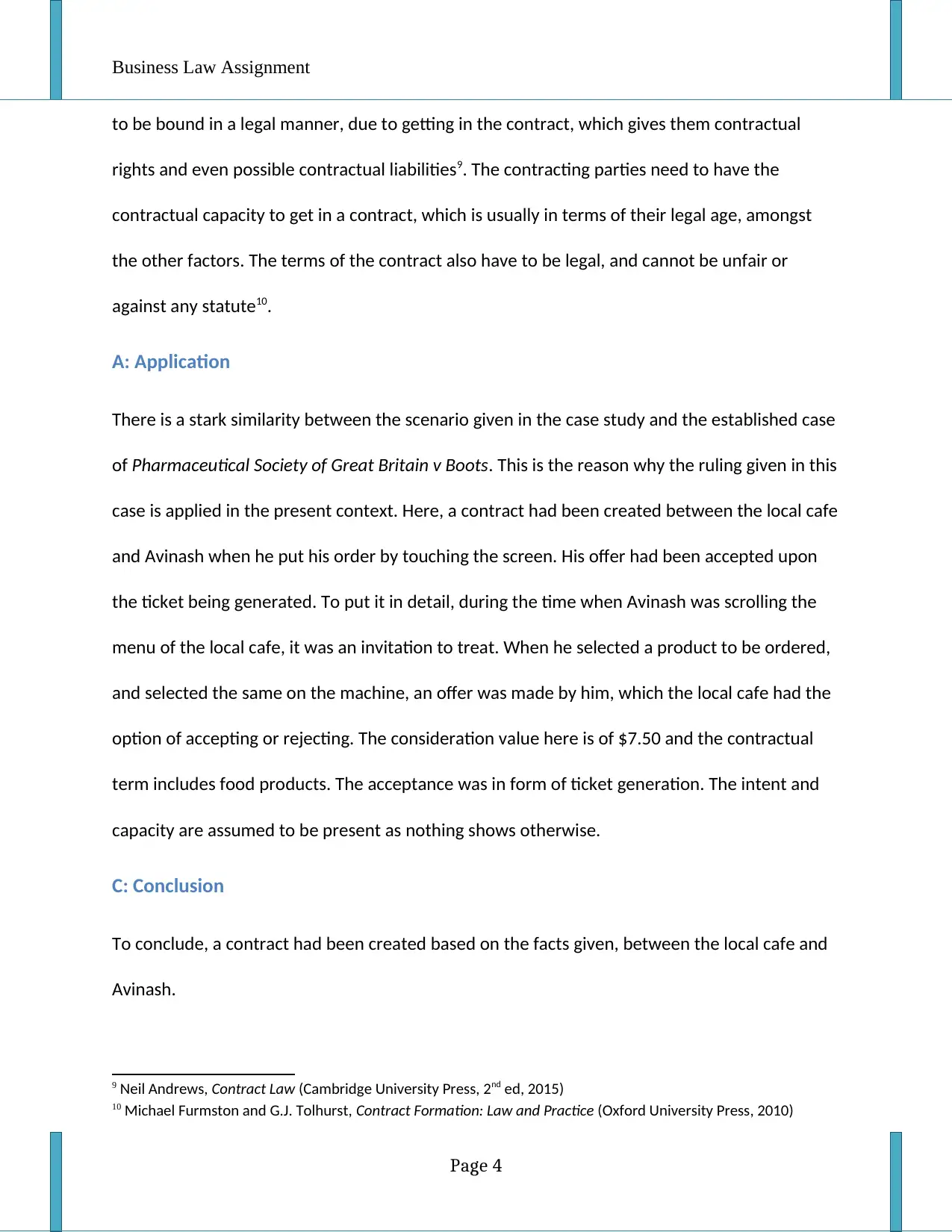
Business Law Assignment
to be bound in a legal manner, due to getting in the contract, which gives them contractual
rights and even possible contractual liabilities9. The contracting parties need to have the
contractual capacity to get in a contract, which is usually in terms of their legal age, amongst
the other factors. The terms of the contract also have to be legal, and cannot be unfair or
against any statute10.
A: Application
There is a stark similarity between the scenario given in the case study and the established case
of Pharmaceutical Society of Great Britain v Boots. This is the reason why the ruling given in this
case is applied in the present context. Here, a contract had been created between the local cafe
and Avinash when he put his order by touching the screen. His offer had been accepted upon
the ticket being generated. To put it in detail, during the time when Avinash was scrolling the
menu of the local cafe, it was an invitation to treat. When he selected a product to be ordered,
and selected the same on the machine, an offer was made by him, which the local cafe had the
option of accepting or rejecting. The consideration value here is of $7.50 and the contractual
term includes food products. The acceptance was in form of ticket generation. The intent and
capacity are assumed to be present as nothing shows otherwise.
C: Conclusion
To conclude, a contract had been created based on the facts given, between the local cafe and
Avinash.
9 Neil Andrews, Contract Law (Cambridge University Press, 2nd ed, 2015)
10 Michael Furmston and G.J. Tolhurst, Contract Formation: Law and Practice (Oxford University Press, 2010)
Page 4
to be bound in a legal manner, due to getting in the contract, which gives them contractual
rights and even possible contractual liabilities9. The contracting parties need to have the
contractual capacity to get in a contract, which is usually in terms of their legal age, amongst
the other factors. The terms of the contract also have to be legal, and cannot be unfair or
against any statute10.
A: Application
There is a stark similarity between the scenario given in the case study and the established case
of Pharmaceutical Society of Great Britain v Boots. This is the reason why the ruling given in this
case is applied in the present context. Here, a contract had been created between the local cafe
and Avinash when he put his order by touching the screen. His offer had been accepted upon
the ticket being generated. To put it in detail, during the time when Avinash was scrolling the
menu of the local cafe, it was an invitation to treat. When he selected a product to be ordered,
and selected the same on the machine, an offer was made by him, which the local cafe had the
option of accepting or rejecting. The consideration value here is of $7.50 and the contractual
term includes food products. The acceptance was in form of ticket generation. The intent and
capacity are assumed to be present as nothing shows otherwise.
C: Conclusion
To conclude, a contract had been created based on the facts given, between the local cafe and
Avinash.
9 Neil Andrews, Contract Law (Cambridge University Press, 2nd ed, 2015)
10 Michael Furmston and G.J. Tolhurst, Contract Formation: Law and Practice (Oxford University Press, 2010)
Page 4
Secure Best Marks with AI Grader
Need help grading? Try our AI Grader for instant feedback on your assignments.
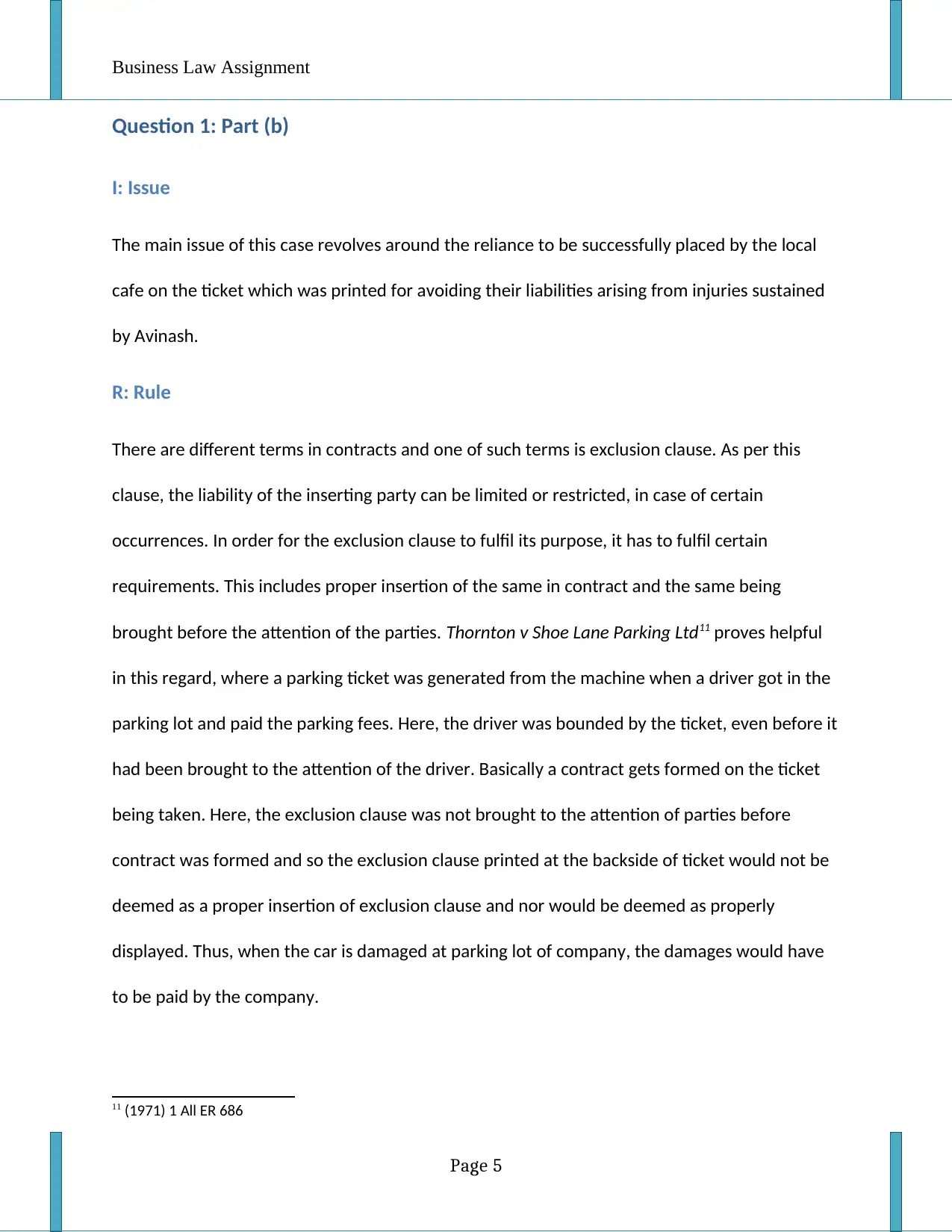
Business Law Assignment
Question 1: Part (b)
I: Issue
The main issue of this case revolves around the reliance to be successfully placed by the local
cafe on the ticket which was printed for avoiding their liabilities arising from injuries sustained
by Avinash.
R: Rule
There are different terms in contracts and one of such terms is exclusion clause. As per this
clause, the liability of the inserting party can be limited or restricted, in case of certain
occurrences. In order for the exclusion clause to fulfil its purpose, it has to fulfil certain
requirements. This includes proper insertion of the same in contract and the same being
brought before the attention of the parties. Thornton v Shoe Lane Parking Ltd11 proves helpful
in this regard, where a parking ticket was generated from the machine when a driver got in the
parking lot and paid the parking fees. Here, the driver was bounded by the ticket, even before it
had been brought to the attention of the driver. Basically a contract gets formed on the ticket
being taken. Here, the exclusion clause was not brought to the attention of parties before
contract was formed and so the exclusion clause printed at the backside of ticket would not be
deemed as a proper insertion of exclusion clause and nor would be deemed as properly
displayed. Thus, when the car is damaged at parking lot of company, the damages would have
to be paid by the company.
11 (1971) 1 All ER 686
Page 5
Question 1: Part (b)
I: Issue
The main issue of this case revolves around the reliance to be successfully placed by the local
cafe on the ticket which was printed for avoiding their liabilities arising from injuries sustained
by Avinash.
R: Rule
There are different terms in contracts and one of such terms is exclusion clause. As per this
clause, the liability of the inserting party can be limited or restricted, in case of certain
occurrences. In order for the exclusion clause to fulfil its purpose, it has to fulfil certain
requirements. This includes proper insertion of the same in contract and the same being
brought before the attention of the parties. Thornton v Shoe Lane Parking Ltd11 proves helpful
in this regard, where a parking ticket was generated from the machine when a driver got in the
parking lot and paid the parking fees. Here, the driver was bounded by the ticket, even before it
had been brought to the attention of the driver. Basically a contract gets formed on the ticket
being taken. Here, the exclusion clause was not brought to the attention of parties before
contract was formed and so the exclusion clause printed at the backside of ticket would not be
deemed as a proper insertion of exclusion clause and nor would be deemed as properly
displayed. Thus, when the car is damaged at parking lot of company, the damages would have
to be paid by the company.
11 (1971) 1 All ER 686
Page 5
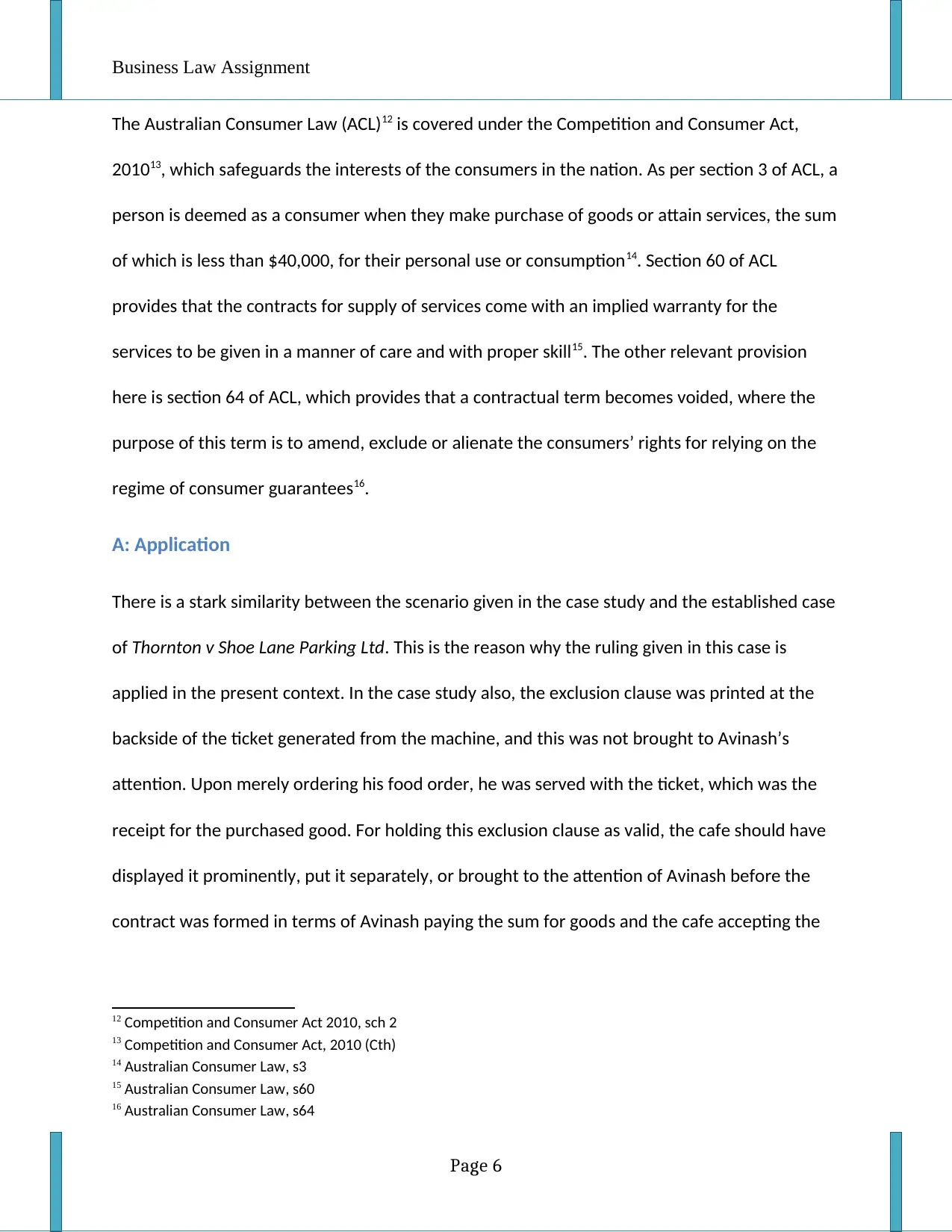
Business Law Assignment
The Australian Consumer Law (ACL)12 is covered under the Competition and Consumer Act,
201013, which safeguards the interests of the consumers in the nation. As per section 3 of ACL, a
person is deemed as a consumer when they make purchase of goods or attain services, the sum
of which is less than $40,000, for their personal use or consumption14. Section 60 of ACL
provides that the contracts for supply of services come with an implied warranty for the
services to be given in a manner of care and with proper skill15. The other relevant provision
here is section 64 of ACL, which provides that a contractual term becomes voided, where the
purpose of this term is to amend, exclude or alienate the consumers’ rights for relying on the
regime of consumer guarantees16.
A: Application
There is a stark similarity between the scenario given in the case study and the established case
of Thornton v Shoe Lane Parking Ltd. This is the reason why the ruling given in this case is
applied in the present context. In the case study also, the exclusion clause was printed at the
backside of the ticket generated from the machine, and this was not brought to Avinash’s
attention. Upon merely ordering his food order, he was served with the ticket, which was the
receipt for the purchased good. For holding this exclusion clause as valid, the cafe should have
displayed it prominently, put it separately, or brought to the attention of Avinash before the
contract was formed in terms of Avinash paying the sum for goods and the cafe accepting the
12 Competition and Consumer Act 2010, sch 2
13 Competition and Consumer Act, 2010 (Cth)
14 Australian Consumer Law, s3
15 Australian Consumer Law, s60
16 Australian Consumer Law, s64
Page 6
The Australian Consumer Law (ACL)12 is covered under the Competition and Consumer Act,
201013, which safeguards the interests of the consumers in the nation. As per section 3 of ACL, a
person is deemed as a consumer when they make purchase of goods or attain services, the sum
of which is less than $40,000, for their personal use or consumption14. Section 60 of ACL
provides that the contracts for supply of services come with an implied warranty for the
services to be given in a manner of care and with proper skill15. The other relevant provision
here is section 64 of ACL, which provides that a contractual term becomes voided, where the
purpose of this term is to amend, exclude or alienate the consumers’ rights for relying on the
regime of consumer guarantees16.
A: Application
There is a stark similarity between the scenario given in the case study and the established case
of Thornton v Shoe Lane Parking Ltd. This is the reason why the ruling given in this case is
applied in the present context. In the case study also, the exclusion clause was printed at the
backside of the ticket generated from the machine, and this was not brought to Avinash’s
attention. Upon merely ordering his food order, he was served with the ticket, which was the
receipt for the purchased good. For holding this exclusion clause as valid, the cafe should have
displayed it prominently, put it separately, or brought to the attention of Avinash before the
contract was formed in terms of Avinash paying the sum for goods and the cafe accepting the
12 Competition and Consumer Act 2010, sch 2
13 Competition and Consumer Act, 2010 (Cth)
14 Australian Consumer Law, s3
15 Australian Consumer Law, s60
16 Australian Consumer Law, s64
Page 6
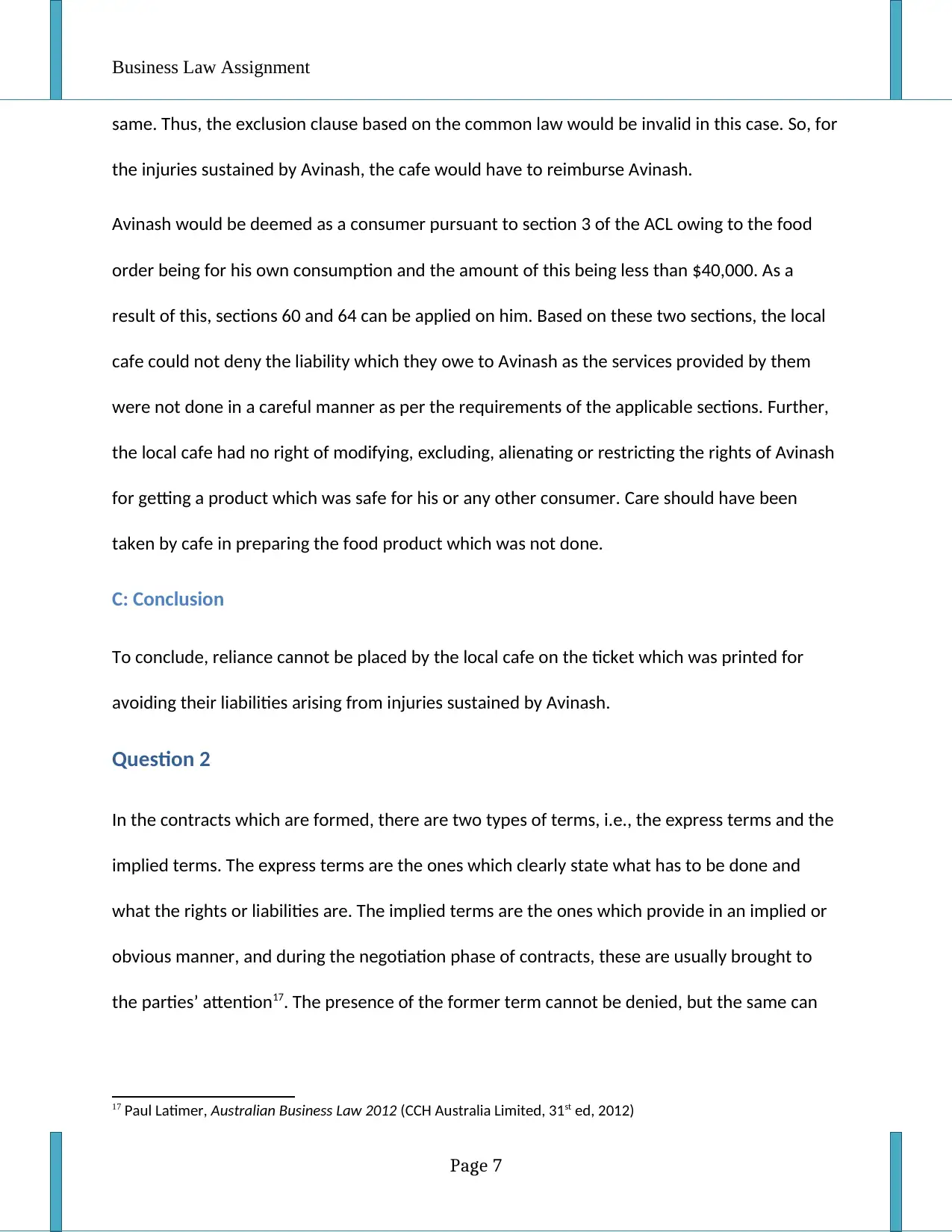
Business Law Assignment
same. Thus, the exclusion clause based on the common law would be invalid in this case. So, for
the injuries sustained by Avinash, the cafe would have to reimburse Avinash.
Avinash would be deemed as a consumer pursuant to section 3 of the ACL owing to the food
order being for his own consumption and the amount of this being less than $40,000. As a
result of this, sections 60 and 64 can be applied on him. Based on these two sections, the local
cafe could not deny the liability which they owe to Avinash as the services provided by them
were not done in a careful manner as per the requirements of the applicable sections. Further,
the local cafe had no right of modifying, excluding, alienating or restricting the rights of Avinash
for getting a product which was safe for his or any other consumer. Care should have been
taken by cafe in preparing the food product which was not done.
C: Conclusion
To conclude, reliance cannot be placed by the local cafe on the ticket which was printed for
avoiding their liabilities arising from injuries sustained by Avinash.
Question 2
In the contracts which are formed, there are two types of terms, i.e., the express terms and the
implied terms. The express terms are the ones which clearly state what has to be done and
what the rights or liabilities are. The implied terms are the ones which provide in an implied or
obvious manner, and during the negotiation phase of contracts, these are usually brought to
the parties’ attention17. The presence of the former term cannot be denied, but the same can
17 Paul Latimer, Australian Business Law 2012 (CCH Australia Limited, 31st ed, 2012)
Page 7
same. Thus, the exclusion clause based on the common law would be invalid in this case. So, for
the injuries sustained by Avinash, the cafe would have to reimburse Avinash.
Avinash would be deemed as a consumer pursuant to section 3 of the ACL owing to the food
order being for his own consumption and the amount of this being less than $40,000. As a
result of this, sections 60 and 64 can be applied on him. Based on these two sections, the local
cafe could not deny the liability which they owe to Avinash as the services provided by them
were not done in a careful manner as per the requirements of the applicable sections. Further,
the local cafe had no right of modifying, excluding, alienating or restricting the rights of Avinash
for getting a product which was safe for his or any other consumer. Care should have been
taken by cafe in preparing the food product which was not done.
C: Conclusion
To conclude, reliance cannot be placed by the local cafe on the ticket which was printed for
avoiding their liabilities arising from injuries sustained by Avinash.
Question 2
In the contracts which are formed, there are two types of terms, i.e., the express terms and the
implied terms. The express terms are the ones which clearly state what has to be done and
what the rights or liabilities are. The implied terms are the ones which provide in an implied or
obvious manner, and during the negotiation phase of contracts, these are usually brought to
the parties’ attention17. The presence of the former term cannot be denied, but the same can
17 Paul Latimer, Australian Business Law 2012 (CCH Australia Limited, 31st ed, 2012)
Page 7
Paraphrase This Document
Need a fresh take? Get an instant paraphrase of this document with our AI Paraphraser
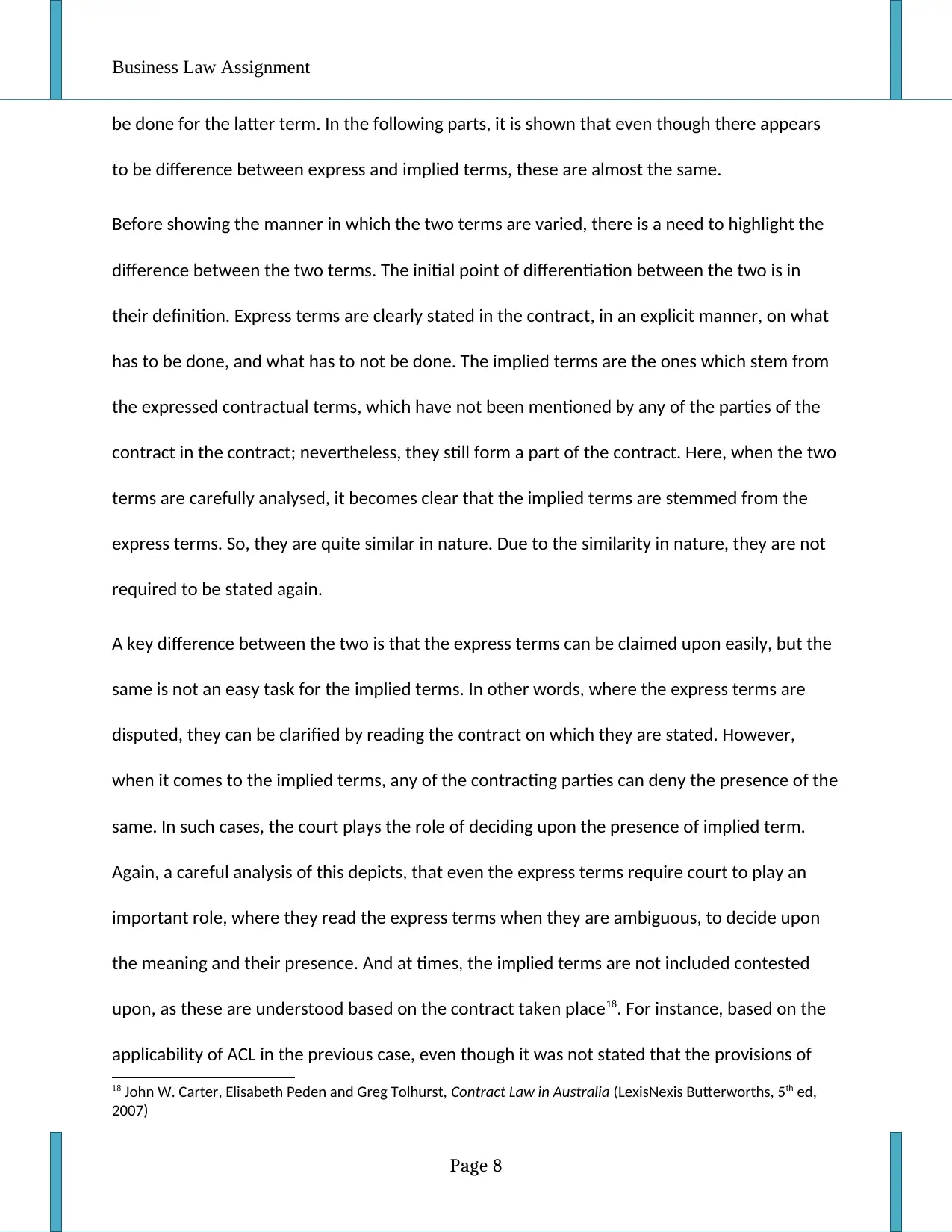
Business Law Assignment
be done for the latter term. In the following parts, it is shown that even though there appears
to be difference between express and implied terms, these are almost the same.
Before showing the manner in which the two terms are varied, there is a need to highlight the
difference between the two terms. The initial point of differentiation between the two is in
their definition. Express terms are clearly stated in the contract, in an explicit manner, on what
has to be done, and what has to not be done. The implied terms are the ones which stem from
the expressed contractual terms, which have not been mentioned by any of the parties of the
contract in the contract; nevertheless, they still form a part of the contract. Here, when the two
terms are carefully analysed, it becomes clear that the implied terms are stemmed from the
express terms. So, they are quite similar in nature. Due to the similarity in nature, they are not
required to be stated again.
A key difference between the two is that the express terms can be claimed upon easily, but the
same is not an easy task for the implied terms. In other words, where the express terms are
disputed, they can be clarified by reading the contract on which they are stated. However,
when it comes to the implied terms, any of the contracting parties can deny the presence of the
same. In such cases, the court plays the role of deciding upon the presence of implied term.
Again, a careful analysis of this depicts, that even the express terms require court to play an
important role, where they read the express terms when they are ambiguous, to decide upon
the meaning and their presence. And at times, the implied terms are not included contested
upon, as these are understood based on the contract taken place18. For instance, based on the
applicability of ACL in the previous case, even though it was not stated that the provisions of
18 John W. Carter, Elisabeth Peden and Greg Tolhurst, Contract Law in Australia (LexisNexis Butterworths, 5th ed,
2007)
Page 8
be done for the latter term. In the following parts, it is shown that even though there appears
to be difference between express and implied terms, these are almost the same.
Before showing the manner in which the two terms are varied, there is a need to highlight the
difference between the two terms. The initial point of differentiation between the two is in
their definition. Express terms are clearly stated in the contract, in an explicit manner, on what
has to be done, and what has to not be done. The implied terms are the ones which stem from
the expressed contractual terms, which have not been mentioned by any of the parties of the
contract in the contract; nevertheless, they still form a part of the contract. Here, when the two
terms are carefully analysed, it becomes clear that the implied terms are stemmed from the
express terms. So, they are quite similar in nature. Due to the similarity in nature, they are not
required to be stated again.
A key difference between the two is that the express terms can be claimed upon easily, but the
same is not an easy task for the implied terms. In other words, where the express terms are
disputed, they can be clarified by reading the contract on which they are stated. However,
when it comes to the implied terms, any of the contracting parties can deny the presence of the
same. In such cases, the court plays the role of deciding upon the presence of implied term.
Again, a careful analysis of this depicts, that even the express terms require court to play an
important role, where they read the express terms when they are ambiguous, to decide upon
the meaning and their presence. And at times, the implied terms are not included contested
upon, as these are understood based on the contract taken place18. For instance, based on the
applicability of ACL in the previous case, even though it was not stated that the provisions of
18 John W. Carter, Elisabeth Peden and Greg Tolhurst, Contract Law in Australia (LexisNexis Butterworths, 5th ed,
2007)
Page 8
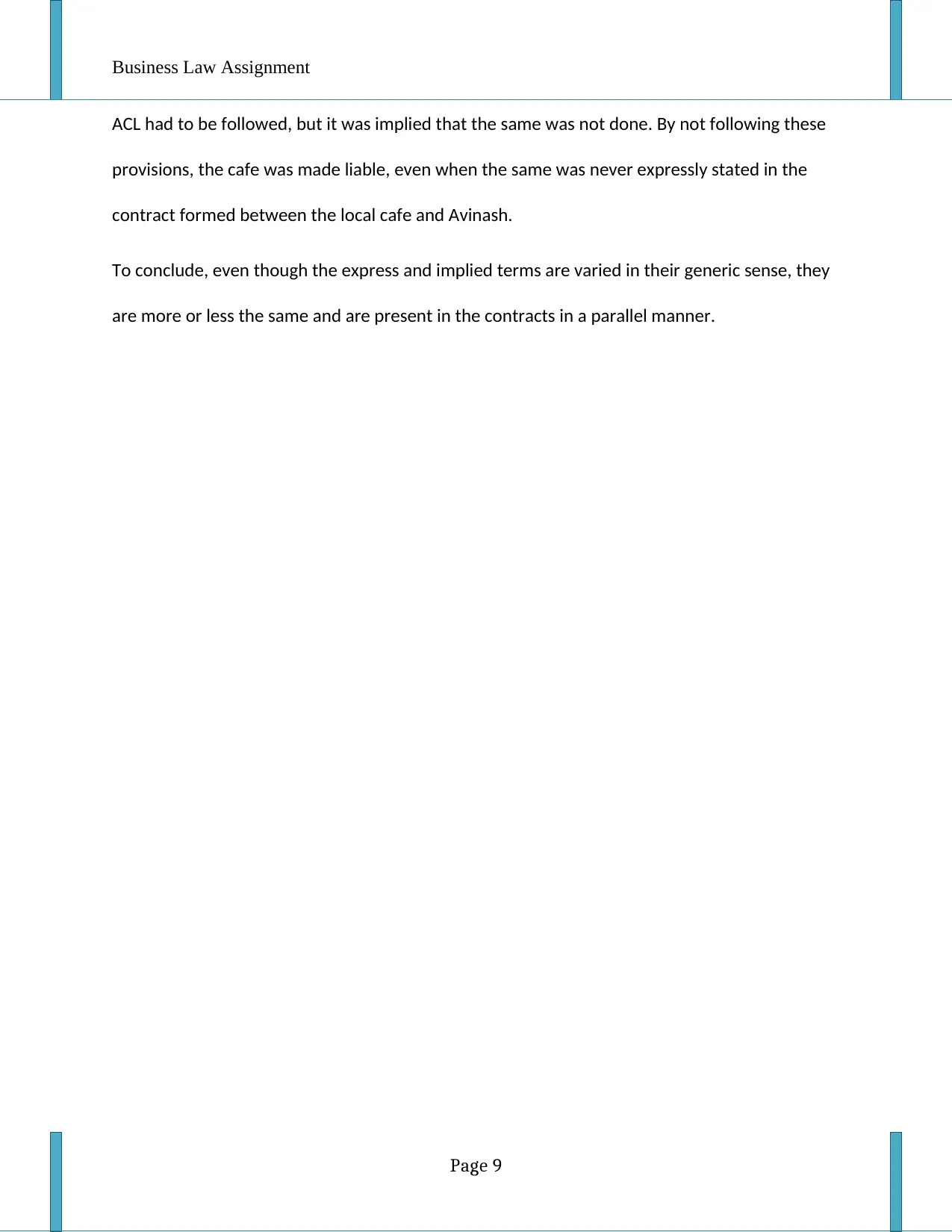
Business Law Assignment
ACL had to be followed, but it was implied that the same was not done. By not following these
provisions, the cafe was made liable, even when the same was never expressly stated in the
contract formed between the local cafe and Avinash.
To conclude, even though the express and implied terms are varied in their generic sense, they
are more or less the same and are present in the contracts in a parallel manner.
Page 9
ACL had to be followed, but it was implied that the same was not done. By not following these
provisions, the cafe was made liable, even when the same was never expressly stated in the
contract formed between the local cafe and Avinash.
To conclude, even though the express and implied terms are varied in their generic sense, they
are more or less the same and are present in the contracts in a parallel manner.
Page 9
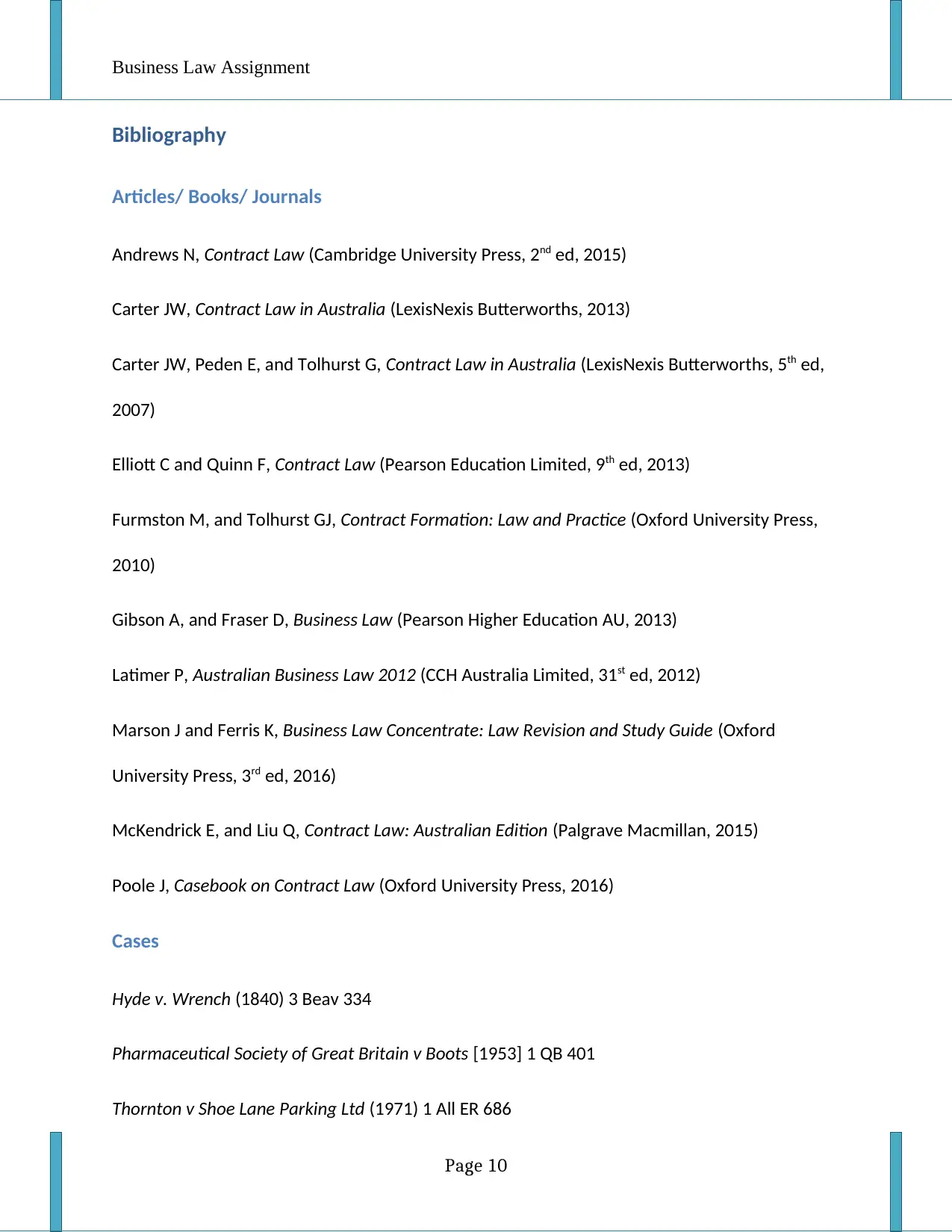
Business Law Assignment
Bibliography
Articles/ Books/ Journals
Andrews N, Contract Law (Cambridge University Press, 2nd ed, 2015)
Carter JW, Contract Law in Australia (LexisNexis Butterworths, 2013)
Carter JW, Peden E, and Tolhurst G, Contract Law in Australia (LexisNexis Butterworths, 5th ed,
2007)
Elliott C and Quinn F, Contract Law (Pearson Education Limited, 9th ed, 2013)
Furmston M, and Tolhurst GJ, Contract Formation: Law and Practice (Oxford University Press,
2010)
Gibson A, and Fraser D, Business Law (Pearson Higher Education AU, 2013)
Latimer P, Australian Business Law 2012 (CCH Australia Limited, 31st ed, 2012)
Marson J and Ferris K, Business Law Concentrate: Law Revision and Study Guide (Oxford
University Press, 3rd ed, 2016)
McKendrick E, and Liu Q, Contract Law: Australian Edition (Palgrave Macmillan, 2015)
Poole J, Casebook on Contract Law (Oxford University Press, 2016)
Cases
Hyde v. Wrench (1840) 3 Beav 334
Pharmaceutical Society of Great Britain v Boots [1953] 1 QB 401
Thornton v Shoe Lane Parking Ltd (1971) 1 All ER 686
Page 10
Bibliography
Articles/ Books/ Journals
Andrews N, Contract Law (Cambridge University Press, 2nd ed, 2015)
Carter JW, Contract Law in Australia (LexisNexis Butterworths, 2013)
Carter JW, Peden E, and Tolhurst G, Contract Law in Australia (LexisNexis Butterworths, 5th ed,
2007)
Elliott C and Quinn F, Contract Law (Pearson Education Limited, 9th ed, 2013)
Furmston M, and Tolhurst GJ, Contract Formation: Law and Practice (Oxford University Press,
2010)
Gibson A, and Fraser D, Business Law (Pearson Higher Education AU, 2013)
Latimer P, Australian Business Law 2012 (CCH Australia Limited, 31st ed, 2012)
Marson J and Ferris K, Business Law Concentrate: Law Revision and Study Guide (Oxford
University Press, 3rd ed, 2016)
McKendrick E, and Liu Q, Contract Law: Australian Edition (Palgrave Macmillan, 2015)
Poole J, Casebook on Contract Law (Oxford University Press, 2016)
Cases
Hyde v. Wrench (1840) 3 Beav 334
Pharmaceutical Society of Great Britain v Boots [1953] 1 QB 401
Thornton v Shoe Lane Parking Ltd (1971) 1 All ER 686
Page 10
Secure Best Marks with AI Grader
Need help grading? Try our AI Grader for instant feedback on your assignments.
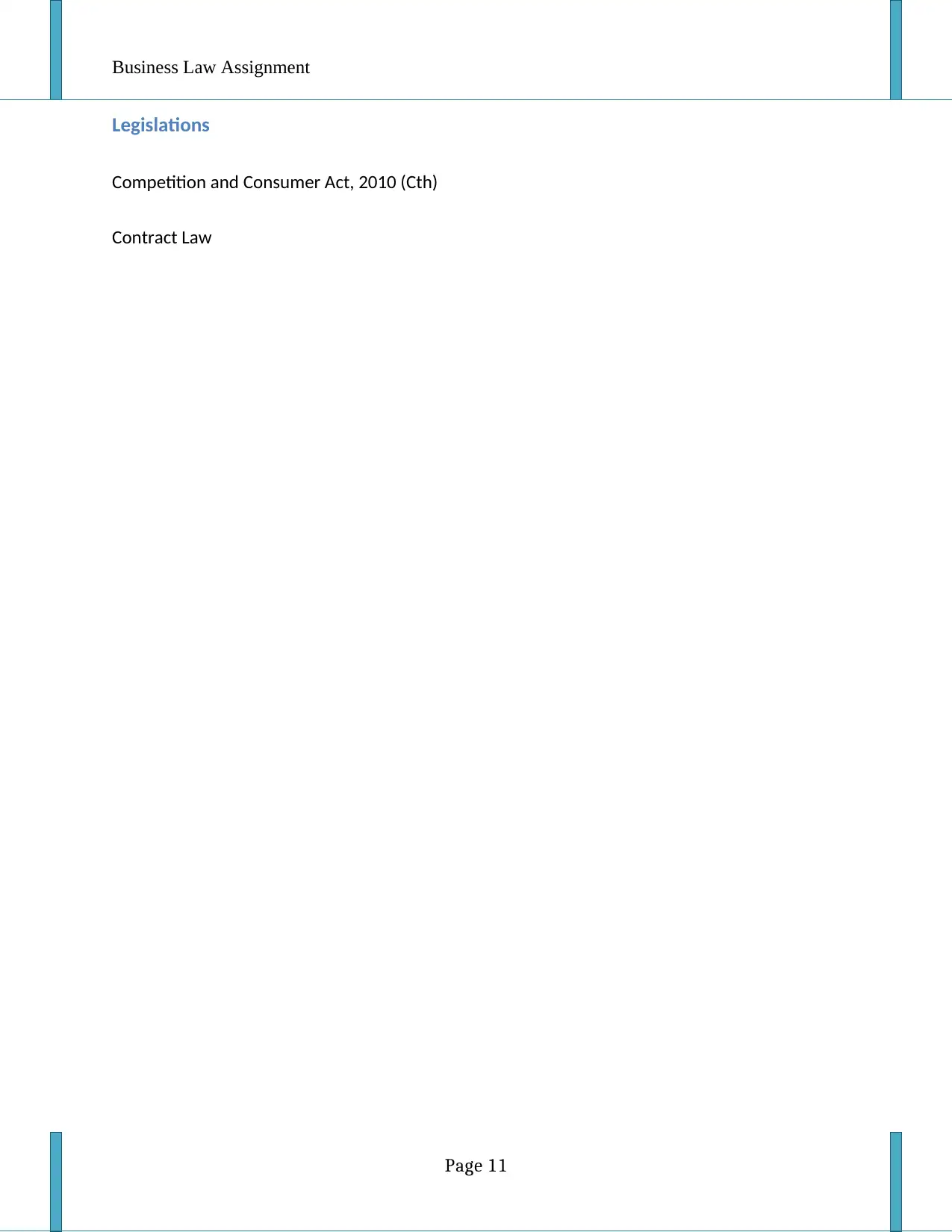
Business Law Assignment
Legislations
Competition and Consumer Act, 2010 (Cth)
Contract Law
Page 11
Legislations
Competition and Consumer Act, 2010 (Cth)
Contract Law
Page 11
1 out of 11
Related Documents
Your All-in-One AI-Powered Toolkit for Academic Success.
+13062052269
info@desklib.com
Available 24*7 on WhatsApp / Email
![[object Object]](/_next/static/media/star-bottom.7253800d.svg)
Unlock your academic potential
© 2024 | Zucol Services PVT LTD | All rights reserved.





